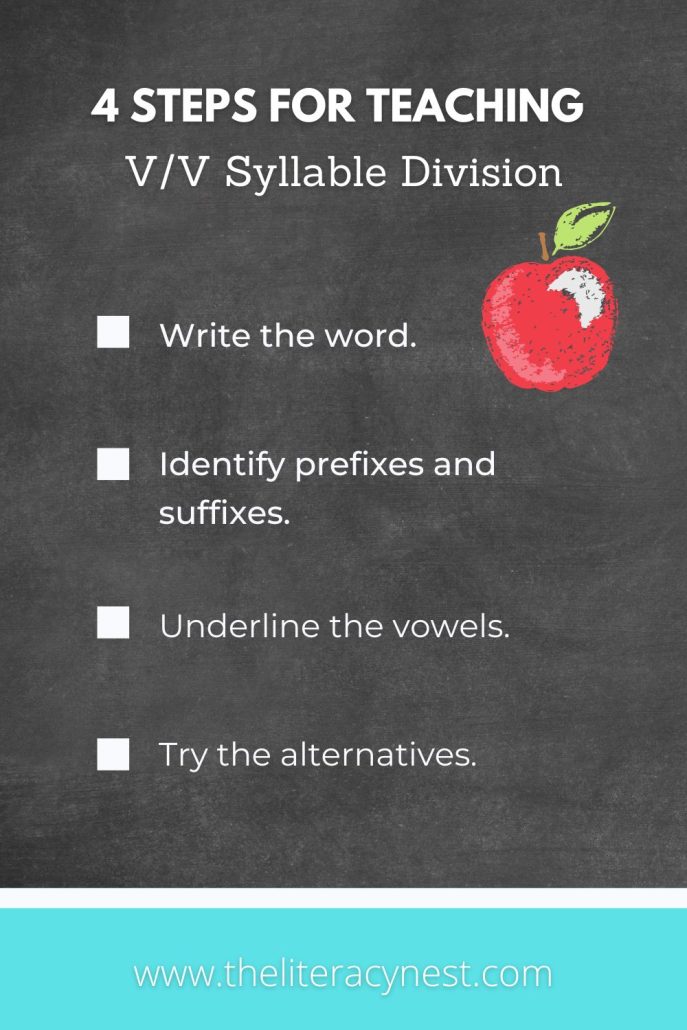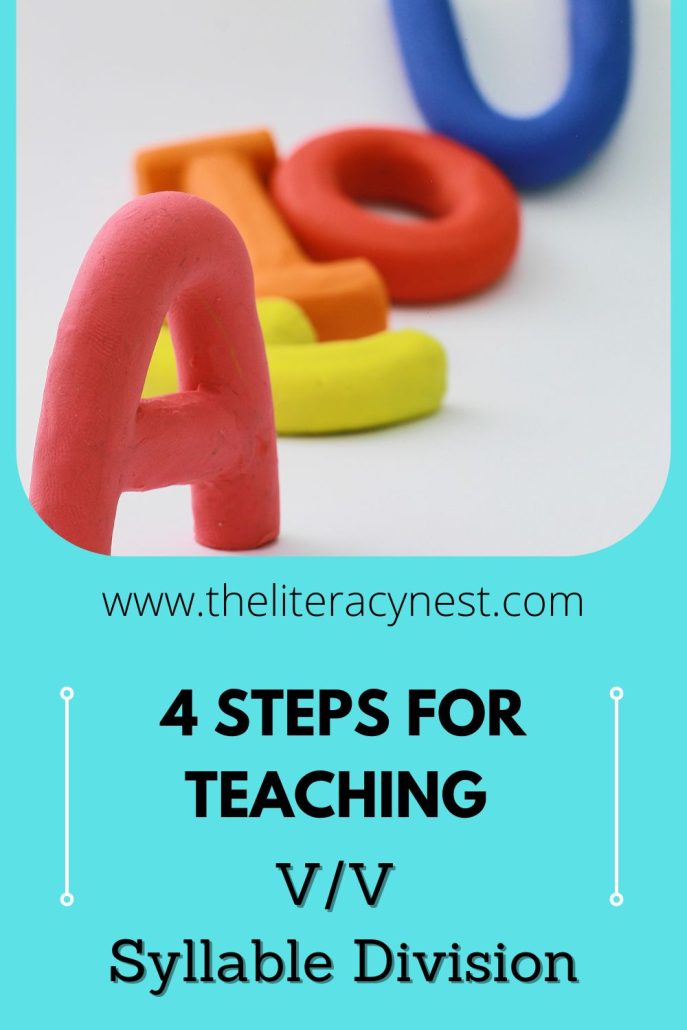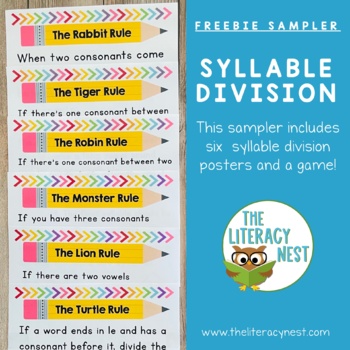4 Steps for Teaching V/V Syllable Division

This is the final part of our series on syllable division. The easiest and most common type of syllable division is the division between consonants. The next most common are the V/CV syllable division and VC/V, also discussed previously. The black sheep of the family was in our post on C+LE syllable division. Only one type of syllable division remains. The least common one is the division between two vowels or V/V syllable division.
Check out the previous posts in this series:
- Syllable Division Between Consonants
- 7 Steps for Teaching V/CV Syllable Division
- 6 Steps for Teaching VC/V Syllable Division
- 7 Steps for Teaching C+LE Syllable Division
Teaching syllable division rules is important because it provides students with a procedure for decoding multi-syllable words allowing them to read a much wider array of books and stories.
Dividing words between vowels is particularly important as students begin to learn more about suffixing rules and adding prefixes to make more complex words.
When to Teach V/V Syllable Division
Dividing words between vowels can be a little tricky to spot. In several ways, it is more well-suited for more advanced learners. Some of these words are relatively short words and look on the surface as if they could be a single vowel team syllable. Other times, this syllable division is a result of adding prefixes to a base word or root, which requires some knowledge of affixes. When the vowel i is part of this pattern, it often makes the ē sound, a more advanced concept.
Just as your students must decide when faced with one consonant between two vowels how to divide the word, there is some flexibility and testing of options required when you may need to divide between vowels. There are several different reasons that V/V syllable division may occur and some predictable patterns. Looking for these patterns in a predictable routine might be helpful.
How to Teach V/V Syllable Division
Step 1: Write the word.
Write a word in large letters on a chalkboard or whiteboard. If teaching remotely, it is helpful to stretch the word so the spacing between letters is loose on the slide or app you are using.
Step 2: Identify prefixes and suffixes.
Sometimes V/V syllable division is a result of affixes. Ask student to identify any prefixes or suffixes they recognize. Prefixes that end in an open syllable such as pre, re, pro etc may wind up with V/V division.
For example: in the word react or cooperate, identifying the prefixes re- and co- automatically leads to the syllable division re/act, co/operate. The remainder of the word cooperate divides according to our previously learned rules. As for suffixes, when you add a vowel suffix to an open syllable as in going or being you encounter V/V division. And, when you change the y to I and add a vowel suffix such as in the word funnier, you will have a V/V syllable division fun/ni/er.
Step 3: Underline vowels.
Ask the student to underline the vowels and look carefully at the underlined vowels and ask themselves a couple of questions.
- “Does this look like a vowel team I know?” (Learn more about Vowel Teams here.)
- “Does this look a bit like a vowel team I know but it looks backward?”

Some of the common V/V syllable division patterns look like backward vowel teams: ia, io, eo, ua. If this seems to be the case, try dividing between the vowels.
Step 4: Try the alternative.
The hardest type of V/V syllables to divide are when the two vowels make a real vowel team as in fluid, create, and poem. These pairs ui, ea, oe are viable vowel teams.

By trying the word and treating them as a single sound, students will often discover either that it almost sounds like a word they know. For example, /pōm/ is very close to /pō ǝm/. This option doesn’t make sense in which case trying the alternative of dividing between the vowels is a good idea.

Download a printable version of this V/V Syllable Division Checklist!
When to Use V/V Syllable Division:
- Often V/V syllable division will have a long vowel sound for the first vowel followed by a schwa.
- Another instance when you might have V/V syllable division is when the word contains a root or combining form that divides between vowels as in bio meaning life.
- Other common reasons you will find syllable division between vowels include words ending in ia as in Australia, media, and trivia.
- Words from Hawaiian frequently divide syllables between vowels as in Oahu and Kauai. In fact, Hawaiian words can have an impressive number of vowels in a row. Sometimes a V/V break will also be indicated with a ‘ mark as in the word for lizard mo’o.
V/V syllable division is the LEAST common type of syllable division. It may take a long time for your students to become masters of this complex pattern.
Building Automaticity
It can be difficult for them to get adequate practice when this occurs so rarely in continuous text. Our goal is to encourage flexibility. V/V syllable division can occur in two-syllable words or words with significantly more than two syllables.
It is important for students to have the chance to build automaticity and flexibility through practice. Following the steps of underlining vowels and marking syllable division is one way to reinforce this. Linking cubes and chenille stems (aka pipe cleaners) make flexible multisensory tools for trying multiple syllable division options. Begin with more hands-on approaches and gradually move to less intensive methods as the process becomes more automatic.
Make it Fun!
Almost any game can be used to practice syllable division, especially for reading. The only limit is your imagination. A simple variation on “Crazy 8s” assigns colors to word cards. Students play using either the same color or the same syllable division pattern. Including wild and draw cards keeps the game extra fun. Extra tricky sorting of words with vowel teams or V/V syllable division might help students discover common letter combinations and patterns.
Are you looking for resources to teach V/V syllable division?
I have multiple resources available for teaching about syllables and syllable division available in my TpT store! I even have an incredible, multi-sensory, FREE resource you can grab, too!
- Syllable Types and Syllable Division for Orton-Gillingham Lessons – BUNDLE
- Here’s a free resource for syllable division!
Save time searching for words with V/V syllable division, check out Word List Builder!
With Word List Builder, you can search for C+LE words, build your folder of words and create templates. Start your 14-day trial today!






